its paid sponsors, whose products you need!
| Home |
| Intro |
| Current Issue |
|
Mailing List |
| Store |
| Strength |
| Subscriber Content |
| ARCHIVES
|
| Martialism |
| Pacifism |
| Q & A |
| Cunning-Hammery |
| Advertise With Us |
| Submit An Article |
| Staff |
| Discussion Forum |
| Links |
“Stay ‘unreasonable.’ If you
don’t like the solutions [available to you], come up with your
own.”
Dan Webre
The Martialist does not
constitute legal advice. It is for ENTERTAINMENT
PURPOSES ONLY.
Copyright © 2003-2004 Phil Elmore, all rights
reserved.
What Strikes Work?
By Sifu Anthony Iglesias
Youll often read or hear debates regarding what strikes
“work,” whats faster or stronger, what’s most and least effective, and so
on. All parties to the debate usually favor one or a few strikes in
particular. Those parties will defend their beloved strikes or methods
with gusto. Are they right? When two people disagree about the nature of
self-defense and what “works,” everyone can’t be right can they? Someone
has to be wrong and someone has to be right right? The answer, like so
much in life, is more complicated than a simple yes or no. When you see
two people disagree in this way, chances are that they’re both right and
they’re both wrong.
A strike is nothing more then a tool and a tool is used “when the time is
right.” You wouldnt use a Phillips head screwdriver on a flat head screw,
would you? Like every tool, every strike we learn has a purpose. The time
and place to use a strike always depend on the circumstances of the
conflict. For example, biting is an effective tool of last resort in a
close combat or groundfighting situation, but you would not make a plan to
bite ahead of time. In the words of one great man, biting is “a good way
to lose one’s teeth.” (We aren’t even considering the possibility of
contracting blood-borne diseases, either.)
A jab is also a very effective tool and one that I have always loved. To
this day, I still use it but like any tool, it has its time and place.
Removed from a boxing context the jab is still useful in the destruction
of the forward limb.
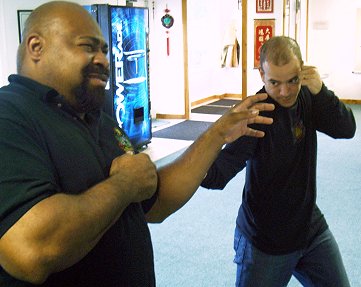
The jab used to destroy the
opponent’s lead limb.
This can set up other strikes like the rear
cross, neck chops, knee strikes, and more. The Wing Chun Sut Sau or Saat Geng
Sau (“kill neck hand”) is incredibly effective and VERY hard to defend against
but only if it used when the timing is right.
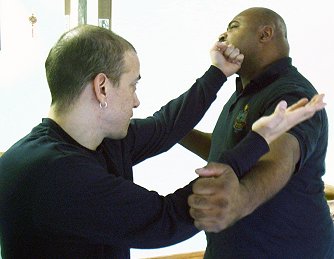
Anthony (left) uses a tan sao and
punch combo…
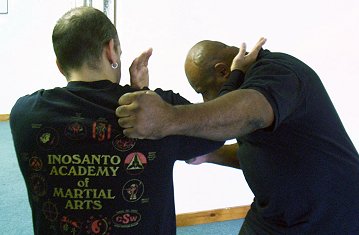
…which sets up the chop to the
neck.
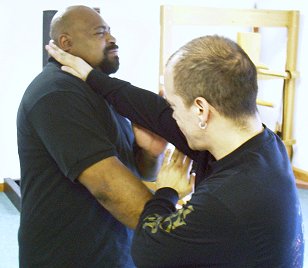
Here is the strike used on the
opposite side.
Elbows are powerful blows that are perfect for
close range fighting situations in which jabs and crosses dont have the
necessary space or leverage. Why do you think boxers clinch? They do it to tie
up jabs and crosses in order to rest. (Remember
how often Lennox Lewis and Mike Tyson clinched each other?)
You can’t count on using a clinch to rest in a street-fighting situation. The
reason for this is simple. There is a weapon or tool for every range of
combat. Be it a punch, an elbow, a chop, a claw, a gouge, a bite, spitting,
kicking, or kneeing, whatever tool of destruction you choose can and is used
in a venue that has no rules.
The key is not to THINK about it. Rorion Gracie said, “Timing is everything.”
He doesn’t “think” about what he’s going to do. He just does it. Bruce Lee
once said, “When the opponent expands, I contract; when he contracts, I
expand; and when there is an opportunity, I do not hit it hits all by
itself.” The truth of a REAL martial artist, a REAL fighter, is worlds apart
from that envisioned by the mere martial hobbyist.
With this said, when is the wrong or right time in which to use a particular
strike? Are you going to pump a jab at close range or try for an elbow at long
range? Are you going to fire off a jab from the mount?
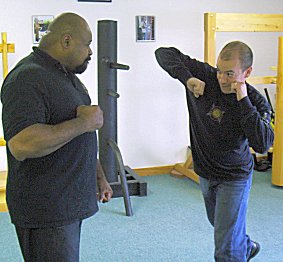
Would you elbow from this range?
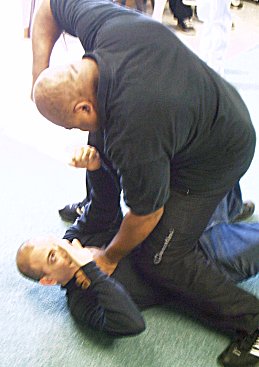
Would you jab while mounted like
this?
Lets also take into account what happens when
you try to launch a strike and fail to land it after repeated attempts. What
if you are pumping your jab against a great counter-puncher or kicker? The jab
is a good tool, but if doesnt seem to be working at the moment, what do you
do? Do you stick with it or try something else? The ability to adapt to the
situation, the flexibility to cope with the unexpected, is a fighter’s
greatest asset. Learning to use “what works” evolves as one’s opponents
change.
Lets take a look at the damage that some strikes can cause. A chop to the
neck seems like an Austin Powers fantasy (“Judo chop!”) but it is a valid
strike. The neck is a very sensitive area that has little bone structure
support (unless you’re eager to absorb blows with your spine). It houses
nerves, arteries, and your vulnerable windpipe.
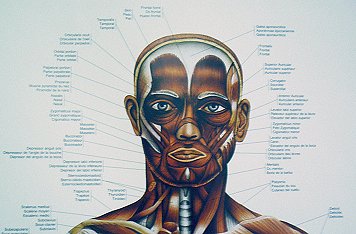
The vulnerable neck, full of targets
of opportunity.
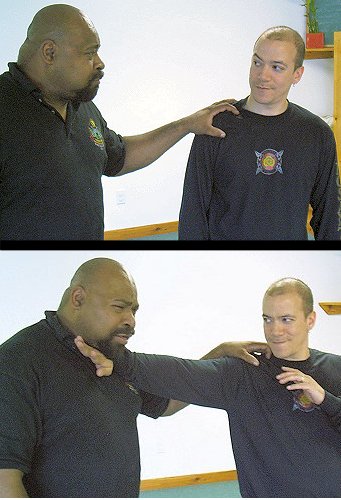
In this sequence, Anthony defends
against a grab
with a simple but efficient chop to the throat.
The chop is a great tool to use in attacking
the neck for several reasons. One reason is that it can slip past the jaw a
lot easier then a fist. Another is that the edge of your hand has less surface
area than does your fist, concentrating your power into a smaller target area.
The lead jab and side kick can cause painful reactions when used to attack the
lead arm or leg of an opponent. Using your pointy knuckles to quickly shoot
out a strike to the forearm area, you can attack the ulna nerve, the wrist
bones, the metacarpals, and the fingers. This will not drop an opponent, but
it can render his lead hand temporarily useless.
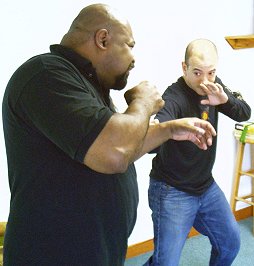
Sifu Anthony strikes Sifu Eric’s lead
arm,
which causes Eric to drop his guard a bit…
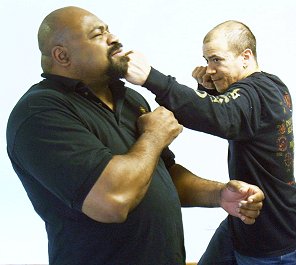
…which makes Anthony’s follow-up
possible.
I’ve heard it said that a strike the eyes is
too difficult, too precise, to pull off in a real-life self-defense situation.
This is, of course, only true if accuracy under pressure has not been
practiced. The finger jab, known as Biu Jee (thrusting fingers) in Wing Chun,
is VERY fast. Accuracy with this and other Wing Chun strikes is practiced
regularly and obsessively. Just as the fencer practices an accurate lunge, the
Wing Chun practitioner hones his finger jab until it is a deadly accurate
strike to the eyes or other sensitive parts of the body.
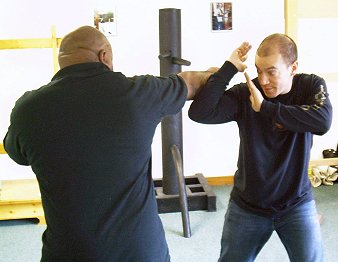
Slipping and blocking a strike turns
into…
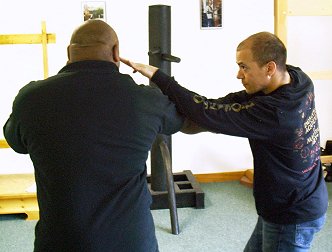
…a strike to the eyes.
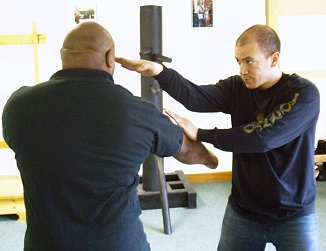
Here is a variation on the strike.
A strike for which you MUST have perfect timing
is the head butt. The head butt works well when your hands are locked up or
when youre on the ground and have no other weapons available. The head butt
is effective when used to attack the soft areas of the face with your much
harder forehead bone. This part of the skull is so tough that there are cases
in which .22 LR and .25 ACP bullets struck it but did not penetrate it.
One of the biggest problems with arguing over which strikes “work” is that too
few of the people engaged in these debates have any real-world experience or
training. More often than not, the arguments are based on the preferences of
the participant’s particular style or sport. An example of this would be a
sportfighter arguing with a combatives practitioner. Thanks to the rules and
in the context of their sports, sportfighters are seldom allowed to gouge
eyes, chop throats, or attack the groin. Because these “other strikes” aren’t
practiced or used in the sports arena, many practitioners of martial sports
ignorantly deem them “fancy” or “low percentage” moves that are ineffective by
definition.
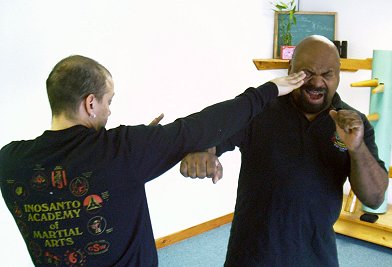
Precision is possible if it is
trained diligently.
To a sportfighter, the jab, cross, hooks,
uppercuts, front and round kicks, and knee strikes are considered the most
effective and highest percentage moves because in the environemnt of a
martial sport, these prove to be the most effective. A practical self-defense
advocate, a Reality Based Self-Defense (RBSD) instructor, or a combatives
exponent would have a very different point of view, however, simply because of
the nature of the training each undergoes. Such RBSD trainees are taught to
use any means necessary to render an attacker unable to continue attacking.
They are taught not to “win the match,” but to survive and escape. The tools
at their disposal include “illegal” strikes. To them, a committed eye strike
(not an accidental one), an elbow, a chop, a groin kick, and any other
technique (regardless of its sanction in sporting circles) is a valid one.
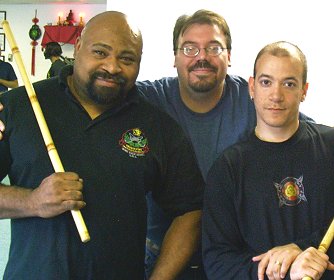
“Attacker” Sifu Eric Winfree (left), photographer
Phil Elmore,
and author Anthony prior to shooting photos for this article.
So who is right regarding the efficacy of the
techniques? Anyone could be right, technically, at any given time depending
on the TIMING of the strike and the context in which it is used.
Volumes can be written regarding whether this
or that strike “works” The answer is always going to be the same.
You must know WHICH tool to
use at the RIGHT time.
